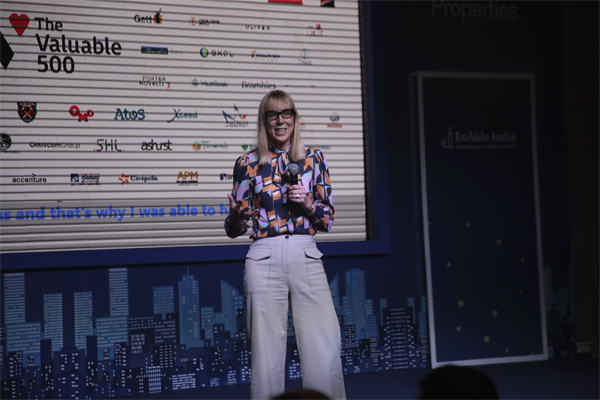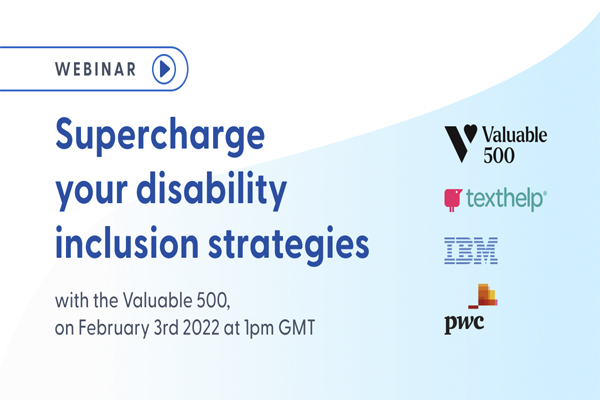In this week’s guest column, Texthelp’s HR Business Partner (UK) Jennifer Ncube outlines three reasons why organisations must take action, and prioritise disability inclusion in their diversity, equity and inclusion strategies.
Businesses all over the world are making great strides to bring equality to gender, race, and LGBT+. But too often, disability is neglected. Around 90% of companies say they prioritise diversity and inclusion (D&I), yet only 4% consider disability in their initiatives.
There are common myths that disability inclusion is complicated or expensive. According to disability charity Leonard Cheshire, around 66% of employers say the costs of workplace adjustments are a barrier to employing a disabled person. But this simply isn’t true.
Research by the Business Disability Forum reveals the positive impact of ‘developing a global disability inclusion strategy’. Of over 100 global brands prioritising disability inclusion, 80% said it allows them to ‘access a wider pool of talent, drives employee motivation, and has impact on business objectives’. Companies that champion disability inclusion also report 30% higher profit margins compared to their peers.
ENDING DISABILITY EXCLUSION
Negative attitudes and stigma also remain a barrier. Around a quarter of employers say they would be less likely to employ someone with a disability, confirms Leonard Cheshire’s recent study. Of these people, 60% say they would be concerned a disabled employee would struggle to do the job.
Commenting on such stigma, Caroline Casey, Founder of The Valuable 500, stated: “People with disabilities bring diversity of thought and lived experience and a wealth of talent, all vital for the business sustainability agenda.” Despite this, just 51.3% of disabled people of working age are employed; compared to 81.4% of non-disabled people.

Organisations must work harder to end exclusion. Below, we explore three key reasons why it’s important to take action now and consider disability in your organisation’s D&I agenda, now and for the future:
1. The rising
According to Leonard Cheshire, around one in five individuals of working age in the UK are disabled or have a long-term health condition. That’s a huge portion of the population to ignore, especially in today’s current climate.
The pandemic has enlightened many workers when it comes to their working life. According to recent research, around one-third are realising new career aspirations. Others have changed employers to improve their work-life balance (26%), reduce stress (21%) and feel more valued at work (21%). A further one in four are planning to change jobs in the future.
Employers that are championing inclusion are becoming employers of choice. Many organisations are realising the need to improve their practices, and focus on creating a culture that’s inclusive of everyone.
Commenting on this topic, Diane Lightfoot, CEO of Business Disability Forum, recently highlighted: “Since the start of the pandemic, we’ve continued to get new members and new partners. They have been saying that they’re joining because of the difficult time and it’s given them a time to think. It’s made them realise that they need to be inclusive across all strands of diversity, that the pandemic has really highlighted that.”

As we look to the future, the need to be disability inclusive continues to grow. By 2050, the number of people living with a disability is expected to double. With each new generation, people are also staying in the workforce longer. Across Europe, 50% of 55-64 year-olds continue to work, compared to just 37% a decade earlier. Given that 46% of people aged 60+ have a disability, there’s an increasing need to pioneer disability inclusion, for current and future generations to come.
2. The unforeseen
Disability affects all of us. Most of us will have a disability in our lifetime, or care for someone with a disability. In fact, according to UK Government statistics 83% of disabilities are acquired, whether due to an accident, illness or genetic condition. Organisations that include disability inclusion in their D&I agenda are better prepared to support employees through life’s events. That’s because they have initiatives and tools in place to help employees adjust to new ways of working and living.
With schemes like the UK government’s Access to Work scheme, employers are empowered to do their part for disability inclusion. Commenting on the value of the scheme, a Texthelp employee with acquired brain injury said: “The Access to Work scheme gave my employers the opportunity to provide me with tools that suited my needs. After meeting with an assessor, they were able to recommend equipment that would help me overcome difficulties I had as a result of my acquired brain injury. When I returned to the workplace, everything was already there ready for me. It was so simple and straightforward. I felt so supported by my employers, and the tools in place give me the opportunity to continue my career successfully. It makes me feel like I have a contribution to make.”
Sadly, not all organisations make use of the available schemes. For many individuals, diagnosis of a disability results in them being undervalued and unwelcome in the workplace. For example, 26% of those diagnosed with Lupus found themselves being dismissed from employment post-diagnosis. Most recently, over half of people with Long Covid have experienced some form of discrimination or disadvantage at work because of their condition.
Organisations must think critically about the inclusivity of their working environments. This can mean looking at the effectiveness of workplace adjustments processes. Effective adjustments empower different ways of working, and give disabled employees the opportunity to thrive in the same way as any other employee. With this, employees often feel more confident to be themselves – and that goes a long way in retaining your talented workforce.

3. The unforgettable
Disabled employees bring a wealth of talent to any organisation. Empathy, tenacity, and resilience are just a few of the characteristics associated with disabled people. By including disability in the D&I agenda, businesses are better placed to attract and retain such talent.
Organisations can also benefit from a workforce that’s more diverse than they think. Disability comes in many forms, from cognitive and behavioural disabilities, to physical disabilities. They can also be permanent, temporary, or situational. As such, disability inclusion strategies often make the workplace a better and more enjoyable place for everyone. This is particularly true for neurodivergent individuals.
Every employee will have preferred ways of working. All staff think differently too. For neurodivergent people with dyslexia, autism, or ADHD, for example, they often think and behave in ways that are more unique to the typical population. With this comes the benefits of out-of-the-box thinking, creative solutions and more.
Organisations that are inclusive of disability often create a culture that embraces different ways of working. Employees are empowered to achieve in their own way. With that, organisations reap the benefits that come with a workforce of different thinkers. And talents that are simply unforgettable. Disability inclusion must become a natural part of any organisation’s D&I strategy. Not only is it the right thing to do for our disabled community, it brings huge benefits for the business agenda, and the wider workforce.

TIME FOR ACTION
On 3rd February at 1pm, join Texthelp’s free webinar with IBM, PwC, and The Valuable 500 – a global business collective made up of 500 CEOs and their companies, innovating together for disability inclusion. Listen as they explore disability inclusion strategies that are moving the needle to support people with disabilities and neurodifferences. Click here for more information about the event.

ABOUT THE AUTHOR
Jennifer Ncube is HR Business Partner, UK, Texthelp, a Disability Confident Employer & global assistive technology provider. She is an experienced and results-driven HR business partner with a passion for creating truly inclusive workplaces where all abilities can thrive. At Texthelp, she is responsible for finding the right talent, enhancing staff performance and wellbeing, and works closely with senior leaders to develop and execute an HR programme that closely supports Texthelp’s objectives.







































